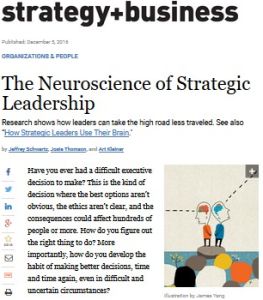
Article
The Neuroscience of Strategic Leadership
Research shows how leaders can take the high road less traveled.
Strategy+business,
2016
Read or listen offline
auto-generated audio
1×
auto-generated audio
Recommendation
What if you could change your results in life by harnessing the power of your thoughts? If you go to work feeling anxious, come home irritated and are often left out of important workplace decisions, the problem may lie within. Jeffrey Schwartz, Josie Thomson and Art Kleiner teach you the power of mindfulness, “mentalizing” and “self-directed neuroplasticity.” The authors advocate for daily meditation sessions and teach you how to make changes to your behavior patterns. getAbstract recommends this summary to people with an interest in optimizing their most valuable resource: brain power.
Take-Aways
About the Authors
Jeffrey Schwartz is a psychiatrist and an author. Josie Thomson is a leadership coach. Art Kleiner is the editor in chief at stragegy+business.


















Comment on this summary or Start Discussion